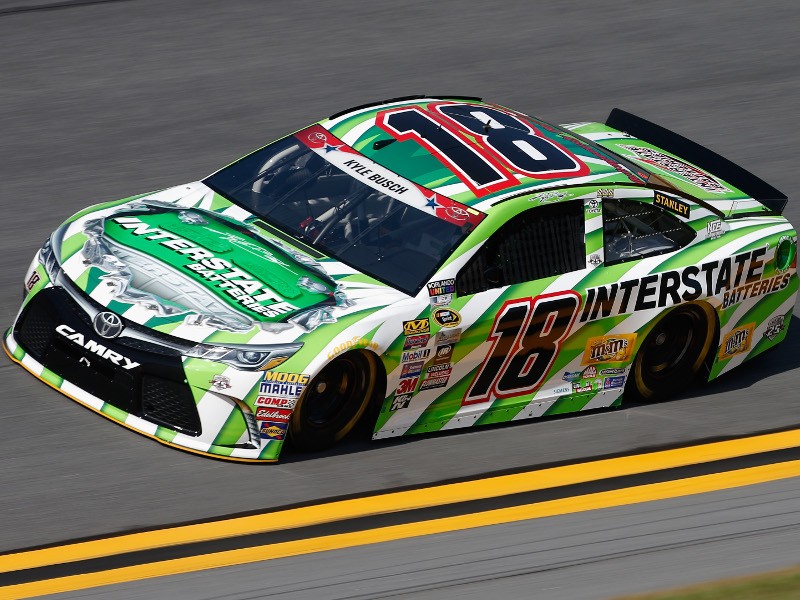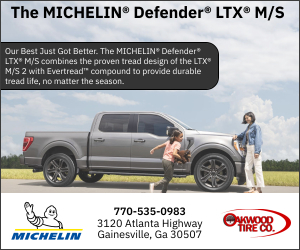DAYTONA BEACH, Fla. - Suddenly and without warning, Kyle Busch’s No. 18 Toyota veered hard to the right and nosed into the outside SAFER barrier at Daytona International Speedway.
The wreck occurred 35 minutes, 47 seconds into Friday morning’s NASCAR Sprint Cup Series practice, a session rescheduled from the day before because of afternoon rains on Thursday.
Busch was second in a four-car line, drafting with teammates Denny Hamlin (who led the pack), Matt Kenseth (running third) and Carl Edwards. As the quartet rolled through turns 1 and 2 at the 2.5-mile track, the right rear tire on Busch’s Camry exploded, sending the car out of control and into the wall.
Busch walked away from the wreck.
“It wasn’t any fun, that’s for sure,” Busch said after a mandatory trip to the infield care center. “Your first instinct is to correct, and the car automatically corrects, and then finally when it catches… or hit the apron and caught, it turned back the other way and headed on into the fence.
“That was certainly a big hit, so you’ve got to thank NASCAR for their safety advancements in the cars and the driver’s equipment and things like that—and of course the SAFER barrier as well. That could have been a heck of a lot worse than what that was.”
A Goodyear spokesperson noted that Busch’s tire had sustained a gash roughly the size of a fist. And Busch, who had to go to a backup car, wasn’t the only Joe Gibbs Racing driver to experience issues with a cut tire on Friday.
Teammate Edwards was far more fortunate. The driver of the No. 19 Toyota brought his car to the garage before his tire suffered a catastrophic failure.
“I felt something vibrating… I thought it was the drive line or the engine,” Edwards said. “We had a puncture in the tread of the left rear tire. It was leaking in the garage. It was five or 10 pounds low when we came in.”
After returning to the track with his teammates, Edwards had a close-up look at Busch’s accident.
“It was Matt in front of me and Kyle in front of him,” Edwards said. “I saw something come out from under Matt’s car and I thought, ‘I wonder what that is?’ Then I saw Kyle sideways.
“He drilled the fence. Honestly, he hit hard enough (that) I was really worried about him. But it seems like he’s OK. Adam (crew chief Stevens) said he was good…It’s just kind of odd to have two out there like that. We were in the same group and had them happen one right after the other. There’s just some debris out there causing punctures. I got lucky because I don’t think I would have stopped if we were racing out there, if I had felt that vibration. It was very slight. I’m fortunate that mine didn’t blow like that. It looked like a pretty violent hit.”
Because the accident occurred with fewer than 10 minutes left in practice, Busch had no opportunity to get laps in the car before Friday’s scheduled 4:10 p.m. ET qualifying session.
Denny Hamlin: I Won’t Make The Same Mistake Next Time
Last Sunday at Sonoma Raceway, Denny Hamlin was in unfamiliar territory.
He was leading a NASCAR Sprint Cup Series race on the final lap at a road course.
With a well-executed tap, Hamlin had passed Tony Stewart for the top spot in turn 7 at the 1.99-mile layout. The driver of the No. 11 Joe Gibbs Racing Toyota held the point through the esses and expanded his advantage through turn 1- to approximately three car-lengths.
But Hamlin went wide in turn 11, the tight hairpin that sets up the run to the finish line. Stewart closed, knocked Hamlin into the outside wall exiting the corner and won the race to change the course of his final season in Sprint Cup racing.
For Stewart, it was a victory of monumental significance.
For Hamlin, it was a lesson learned.
“In my defense… I’ve never been in that position before,” Hamlin said on Thursday at Daytona International Speedway, where, as the winner of the season-opening Daytona 500, he will try to complete a season sweep in Saturday night’s Coke Zero 400. “I’ve not been that competitive on road courses, and so I didn’t know the proper defensive move going into that last corner.
“I’d love to have that situation back again, but I really just didn’t know the proper move. I thought I had two car-lengths. Looking back at the video, I probably had three, and that’s kind of the point where you can just run your own corner and maybe be OK, but I knew he was going to throw caution to the wind and I just – I literally looked up and went to my same braking point and I wheel hopped again, and like it was just anomaly.”
Though Hamlin didn’t leave Sonoma with a trophy, he’ll return next year with a newfound sense of confidence.
“I just made a mistake being in a position I’ve never been in before, but now I have confidence that now every road course I go to I can win those races,” Hamlin said. “And so I think that, when I go back to road course, I know that I can win these races—and really going into Sonoma I didn’t go there with a whole lot of aspirations of winning that race.
“I just haven’t been that great on them. I’ve always struggled for speed. It’s not been because of my cars–it’s been because of me–but now I feel like… I’ll get it before my career is over, for sure.”
Importance Of Handling Returning To Daytona
Before Daytona International Speedway was repaved in 2010, there was a huge difference between the racing characteristics at the Birthplace of Speed and its sister restrictor-plate track, Talladega.
The latter was a wide-open, keep-it-floored affair, while Daytona was known as a handling track where a slick racing surface could play havoc with the ability of cars and drivers to negotiate the corners.
The repaving changed that. For the past few years, Daytona raced much more like Talladega. But, says Dale Earnhardt, Jr., that’s starting to change, and the importance of handling at Daytona is resurfacing, so to speak.
“It’s starting to show some handling issues in the races,” Earnhardt told the NASCAR Wire Service. “We really didn’t see that for a very long time here. I think a lot of us were really surprised how Daytona turned out and how the cars drove…
“It was a complete curveball for me, and a lot of our (Hendrick Motorsports) cars, as far as how the cars drove and how much handling was important to being competitive. Everybody was scrambling in the (2016 Daytona 500), working on the balance trying to get the cars to turn and do everything they needed to do, because we hadn’t had to worry about it before.”
As far as Earnhardt is concerned, the quicker the asphalt matures, the better.
“We loved when this place was slick and bumpy,” he said. “The bumps were getting kind of severe in some spots and the asphalt was coming up in some places, but that was a great challenge. That gave the crews and the crew chiefs a challenge to get the cars to drive well and handle well.
“Everybody would haul butt for five laps, 10 laps, and then about lap 20 you would start to see the cars that were handling move toward the front. It was great. It was a lot of fun. So, I’m excited that the track is sort of easing that way—not as fast as we would like obviously, but the technology these days with the asphalt they put down is so much more impressive than what they had in the ‘90s and ‘80s. These tracks are certainly not aging as fast as they used to.”
WDUN will have live MRN Radio coverage of Saturday's NASCAR Sprint Cup Series Coke Zero 400 from Daytona International Speedway beginning at 6:30 pm on 102.9 FM and AM 550.
NASCAR Sprint Cup Series
Daytona International Speedway – Daytona Beach, FL
Coke Zero 400 – July 1, 2016
Saturday’s Starting Lineup
1. (16) Greg Biffle, Ford, 192.955 mph.
2. (19) Carl Edwards, Toyota, 192.748 mph.
3. (18) Kyle Busch, Toyota, 192.336 mph.
4. (17) Ricky Stenhouse, Jr., Ford, 192.320 mph.
5. (2) Brad Keselowski, Ford, 192.254 mph.
6. (3) Austin Dillon, Chevrolet, 192.254 mph.
7. (20) Matt Kenseth, Toyota, 192.234 mph.
8. (48) Jimmie Johnson, Chevrolet, 192.160 mph.
9. (11) Denny Hamlin, Toyota, 191.975 mph.
10. (41) Kurt Busch, Chevrolet, 191.865 mph.
11. (22) Joey Logano, Ford, 191.400 mph.
12. (21) Ryan Blaney #, Ford, 191.253 mph.
13. (6) Trevor Bayne, Ford, 191.192 mph.
14. (43) Aric Almirola, Ford, 191.115 mph.
15. (78) Martin Truex, Jr., Toyota, 191.103 mph.
16. (88) Dale Earnhardt, Jr., Chevrolet, 191.071 mph.
17. (42) Kyle Larson, Chevrolet, 190.933 mph.
18. (5) Kasey Kahne, Chevrolet, 190.783 mph.
19. (14) Tony Stewart, Chevrolet, 190.670 mph.
20. (13) Casey Mears, Chevrolet, 190.476 mph.
21. (4) Kevin Harvick, Chevrolet, 190.444 mph.
22. (10) Danica Patrick, Chevrolet, 190.440 mph.
23. (31) Ryan Newman, Chevrolet, 190.375 mph.
24. (24) Chase Elliott #, Chevrolet, 190.359 mph.
25. (34) Chris Buescher #, Ford, 190.275 mph.
26. (47) A.J. Allmendinger, Chevrolet, 189.877 mph.
27. (27) Paul Menard, Chevrolet, 189.693 mph.
28. (35) David Gilliland, Ford, 189.470 mph.
29. (1) Jamie McMurray, Chevrolet, 189.211 mph.
30. (44) Brian Scott #, Ford, 188.964 mph.
31. (15) Clint Bowyer, Chevrolet, 188.727 mph.
32. (32) Bobby Labonte, Ford, 188.391 mph.
33. (46) Michael Annett, Chevrolet, 188.344 mph.
34. (38) Landon Cassill, Ford, 188.249 mph.
35. (98) Cole Whitt, Toyota, 187.629 mph.
36. (83) Matt DiBenedetto, Toyota, 187.563 mph.
37. (95) Michael McDowell, Chevrolet, 187.480 mph.
38. (23) David Ragan, Toyota, 187.426 mph.
39. (55) Reed Sorenson, Toyota, 187.025 mph.
40. (7) Regan Smith, Chevrolet, 0.000 mph.
Did Not Qualify
41. (30) Josh Wise, Chevrolet, 184.106 mph.









